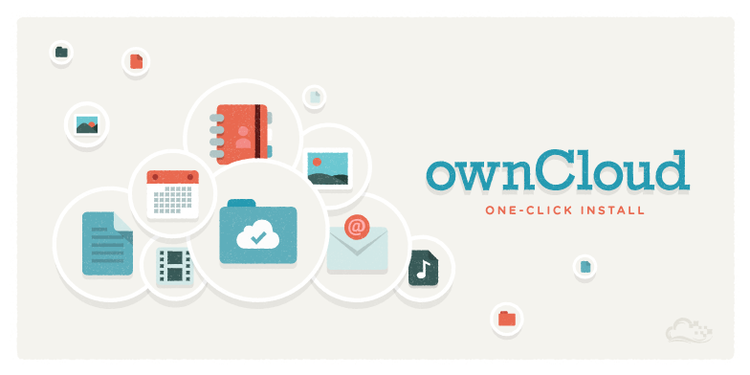

How To Use the ownCloud One-Click Install Application
This One-Click is no longer available - But you can still run ownCloud and Nextcloud on DigitalOcean!
The best way to get started today is to reference the tutorials below, covering installation that starts from a new Ubuntu server.
| UBUNTU USERS: |
|---|
| How To Install and Configure Nextcloud on Ubuntu 16.04 |
| How To Install and Configure ownCloud on Ubuntu 16.04 |
DigitalOcean's ownCloud One-Click application provides a quick way to set up file sharing and other cloud services on a server you control. This tutorial will guide you through the steps to finish configuring your site, including enabling SSL, setting your domain name, and enabling file encryption.
Create a ownCloud Droplet
To start using it, simply create a droplet and specify your hostname and size. It’s recommended that you run ownCloud on at least a 1GB server for a personal instance.

Select your desired region:

Select ownCloud on Ubuntu 14.04 from the Applications tab:

If you use SSH keys to manage your droplets, which are more secure than passwords and are recommended, you can also specify which ones you want added to this server.

Access Your ownCloud Credentials
Once your server has been spun up, you will be able to access the ownCloud installation from your IP address. However, in order to retrieve the randomly generated password for your Admin account, you will need to access the server via the command line.
You can log into your droplet with the following command:
ssh root@your_ip_address
If you are prompted for a password, type in the password that was emailed to you when the server was created. Alternately, if you set up the droplet with SSH keys, you can go ahead and log in without the need for a password.
Once you are logged in, you will see the message of the day (MOTD) which contains your password. It will look like this:
-------------------------------------------------------------------------------------
Thank you for using DigitalOcean's ownCloud Application.
Your ownCloud instance can be accessed at http://xxx.xxx.xx.xxx/
Your ownCloud login credentials are:
Username: admin
Password: XXXXXXXXXX
-------------------------------------------------------------------------------------
Now that you have your login credentials, you can visit your ownCloud site by entering its IP address in your browser.

Secure Your Site with SSL
By default the application image generates a self-signed SSL certificate and uses it to secure your site and make it available over HTTPS.
While secure, a self-signed SSL certificate will generate a warning to visitors of your site. If the ownCloud instance will have other users, you will likely want to obtain an SSL certificate from a proper certificate authority.
A free SSL certificate can be obtained from StartSSL. This tutorial will guide you through the process of installing it from start to finish. Whether you use StartSSL or purchase a certificate from another provider, your next step is to edit your Apache configuration to use your new SSL cert.
nano /etc/apache2/sites-available/owncloud-ssl.conf
Find the lines containing the information for the existing self-signed cert:
SSLEngine on
SSLCertificateFile /etc/apache2/ssl/apache.crt
SSLCertificateKeyFile /etc/apache2/ssl/apache.key
and replace the the paths with the location of the files obtained from your certificate authority.
SSLEngine on
SSLCertificateFile /etc/apache2/ssl/ssl.crt
SSLCertificateKeyFile /etc/apache2/ssl/private.key
SSLCertificateChainFile /etc/apache2/ssl/sub.class1.server.ca.pem
Next, restart Apache in order for the changes to take affect:
sudo service apache2 restart
Whether you use the self-signed cert that comes with the droplet or you install one on your own, you should strongly consider only accessing the site over HTTPS so that all traffic is on a secure and encrypted connection. You can enforce this through a setting in ownCloud. Navigate to the Admin Settings menu:

Then under Security check Enforce HTTPS like so:

Set Up Your Domain
In order to use your own domain with the site, you will need to update your Apache configuration. Edit both /etc/apache2/sites-available/owncloud-ssl.conf and /etc/apache2/sites-available/000-owncloud.conf and replace the line:
#ServerName www.example.com
with:
ServerName your_domain.com
Next, you should edit the trusted_domains entry in you ownCloud configuration. This is located in /var/www/owncloud/config/config.php
'trusted_domains' =>
array (
0 => 'your_domain.com',
),
Once again, you will need to restart Apache in order for the changes to take affect:
sudo service apache2 restart
Enable File Encryption
For additional security, you can encrypt your file contents on disk as well. This require enabling the Encryption plugin. This can be found in the Apps menu:

Once enabled, you will have to log out and then back in again for it to generate your encryption keys. Once done, you can set your recovery password in the Admin Settings menu:

Set Up Your Account
You may also want to change the details of you administrator account including your contact address, username, and password. This can be found in personal settings:

and edited here:

Next Steps
Now that your ownCloud instance is set up and secure, it's time to get to the fun stuff. Besides file sharing, ownCloud comes with calendar, contacts, document editing apps all pre-installed and enabled. You can also install a wide range of third-party apps found on apps.owncloud.com You can also install file syncing clients for your desktop, Android device, or iPhone.

28 Comments